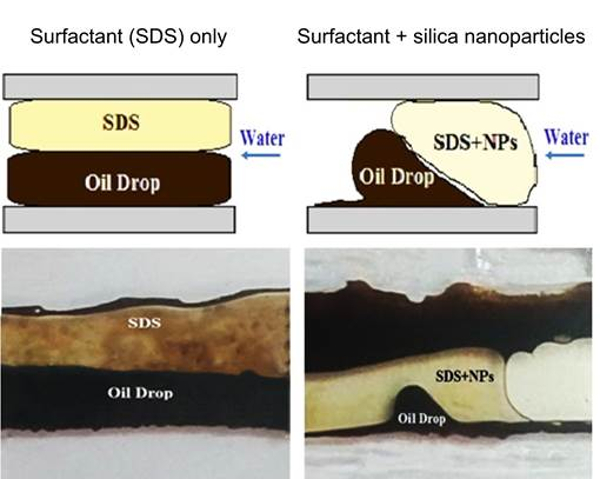
The researchers, from the Energy Safety Research Institute (ESRI) at Swansea University and the Islamic Azad University in Iran, are working on enhanced oil recovery (EOR), the technique which involves extracting oil from wells where most the resources have already been removed. This is often done by pumping other substances into the well to displace the remaining oil, which is sometimes bound to the underground rock formations.
A variety of substances are used for this, ranging from hot water to carbon dioxide and chemical agents such as surfactants. Key to the success of the technique is reducing the surface tension between the oil and water in the well.
The ESRI – Azad team has been working with complexes made up from surfactants and fumed silica nanoparticles. This is a type of silica produced in a flame, which has low density but very high specific surface area. The Swansea researchers used a slightly different technique to investigate the effect of complexes; generally, a technique called core flooding, where a rock sample containing bound oil and water is treated with the EOR materials under test is used; but for this research they used a glass micromodel, which, they explain in the American Chemical Society journal Industrial and Engineering Chemistry Research, gives them better visualisation and understanding of pore space geometry, topology and the effects of the heterogeneous mixture of oil, water and solids.
Unexpectedly, the addition of the fumed silica to the EOR agent improves the proportion of oil recovered from 45 per cent to 58 per cent.
“It is a surprise that the addition of silica nanoparticles, essentially nano-sand, to the surfactant solution leads to such a large flow modification,” said Prof Andrew Barron, who led the team at ESRI. The particles seem to reduce the viscosity of the oil as well as changing the way it interacts with water, both of which contribute to improve the amount of oil that is swept towards the recovery point, he added.
Barron also paid tribute to his collaborators. The research was "great example of international collaboration across borders aimed at developing new materials for minimising the impact of oil production through maximising recovery,” he said.


April 1886: the Brunkebergs tunnel
First ever example of a ground source heat pump?